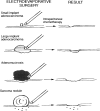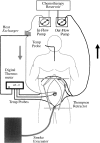Surgical management of carcinomatosis from colorectal cancer
- PMID: 20011302
- PMCID: PMC2780088
- DOI: 10.1055/s-2005-916280
Surgical management of carcinomatosis from colorectal cancer
Abstract
Until recently, peritoneal carcinomatosis from colorectal cancer was a universally fatal manifestation of this cancer. However, two innovations in treatment have improved outcome for these patients. The new surgical interventions are collectively referred to as peritonectomy procedures. During these procedures, all visible cancer is removed in an attempt to leave the patient with only microscopic residual disease. Perioperative intraperitoneal chemotherapy, the second innovation, is employed to eradicate small-volume residual disease. The intraperitoneal chemotherapy is administered in the operating room with moderate hyperthermia and is referred to as heated intraoperative intraperitoneal chemotherapy. If tolerated, additional intraperitoneal chemotherapy can be administered during the first 5 postoperative days. The use of these combined treatments, cytoreductive surgery and intraperitoneal chemotherapy, improves survival, optimizes quality of life, and maximally preserves function. This article describes the natural history of colorectal cancer with carcinomatosis, the patterns of dissemination within the peritoneal cavity, and the benefits and limitations of intraperitoneal chemotherapy. Peritonectomy procedures are defined and described. Also presented are the mechanics of delivering perioperative intraperitoneal chemotherapy and the clinical assessments used to select patients who will benefit from combined treatment. The results of combined treatment for colorectal carcinomatosis are presented.
Keywords: 5-fluorouracil; Peritonectomy; colorectal cancer; hyperthermia; intraperitoneal chemotherapy; mitomycin C; peritoneal surface malignancy.
Figures






Similar articles
-
Managing the peritoneal surface component of gastrointestinal cancer. Part 1. Patterns of dissemination and treatment options.Oncology (Williston Park). 2004 Jan;18(1):51-9. Oncology (Williston Park). 2004. PMID: 14768406 Review.
-
Managing the peritoneal surface component of gastrointestinal cancer. Part 2. Perioperative intraperitoneal chemotherapy.Oncology (Williston Park). 2004 Feb;18(2):207-19; discussion 220-2, 227-8, 230. Oncology (Williston Park). 2004. PMID: 15008058 Review.
-
Successful management of microscopic residual disease in large bowel cancer.Cancer Chemother Pharmacol. 1999;43 Suppl:S15-25. doi: 10.1007/s002800051093. Cancer Chemother Pharmacol. 1999. PMID: 10357554 Review.
-
Treatment of primary colon cancer with peritoneal carcinomatosis: comparison of concomitant vs. delayed management.Dis Colon Rectum. 2000 Oct;43(10):1341-6; discussion 1347-8. doi: 10.1007/BF02236627. Dis Colon Rectum. 2000. PMID: 11052509 Clinical Trial.
-
Pharmacologic rationale for treatments of peritoneal surface malignancy from colorectal cancer.World J Gastrointest Oncol. 2010 Jan 15;2(1):19-30. doi: 10.4251/wjgo.v2.i1.19. World J Gastrointest Oncol. 2010. PMID: 21160813 Free PMC article.
Cited by
-
Extensive Peritonectomy is an Independent Risk Factor for Cisplatin HIPEC-Induced Acute Kidney Injury.Ann Surg Oncol. 2023 May;30(5):2646-2656. doi: 10.1245/s10434-022-12661-3. Epub 2022 Dec 10. Ann Surg Oncol. 2023. PMID: 36496489 Free PMC article.
-
Peritoneal metastases of lower gastrointestinal tract origin:a comparative study of patient outcomes following cytoreduction and intraperitoneal chemotherapy.J Cancer Res Clin Oncol. 2013 Nov;139(11):1899-1908. doi: 10.1007/s00432-013-1507-0. J Cancer Res Clin Oncol. 2013. PMID: 24052322 Free PMC article.
-
Systemic chemotherapy plus cetuximab after complete surgery in the treatment of isolated colorectal peritoneal carcinoma: COCHISE phase II clinical trial.BMC Res Notes. 2019 Jul 22;12(1):450. doi: 10.1186/s13104-019-4476-9. BMC Res Notes. 2019. PMID: 31331370 Free PMC article. Clinical Trial.
-
Current treatment options for colon cancer peritoneal carcinomatosis.World J Gastroenterol. 2014 Sep 21;20(35):12493-500. doi: 10.3748/wjg.v20.i35.12493. World J Gastroenterol. 2014. PMID: 25253949 Free PMC article. Review.
-
Cost Analysis and Financial Implications of a Peritoneal Surface Malignancy Program in the USA.Ann Surg Oncol. 2024 Jan;31(1):630-644. doi: 10.1245/s10434-023-14442-y. Epub 2023 Oct 30. Ann Surg Oncol. 2024. PMID: 37903950
References
-
- Temple WJ, editor. Surgical Techniques and Outcomes. Philadelphia: Surgical Oncology Clinics of North America; WB Saunders; 2002.
-
- Taylor I. What constitutes good practice in surgical oncology? Eur J Surg Oncol. 2001;27:517–520. - PubMed
-
- Spratt J S, Adcock R A, Sherrill W, Tavathen S. Hyperthermia peritoneal perfusion system in canines. Cancer Res. 1980;40:253–255. - PubMed
-
- Speyer J L, Sugarbaker P H, Collins J M, Dedrick R L, Klecker R W, Myers C E. Portal levels and hepatic clearance of 5-fluorouracil after intraperitoneal administration in humans. Cancer Res. 1981;41:1916–1922. - PubMed

